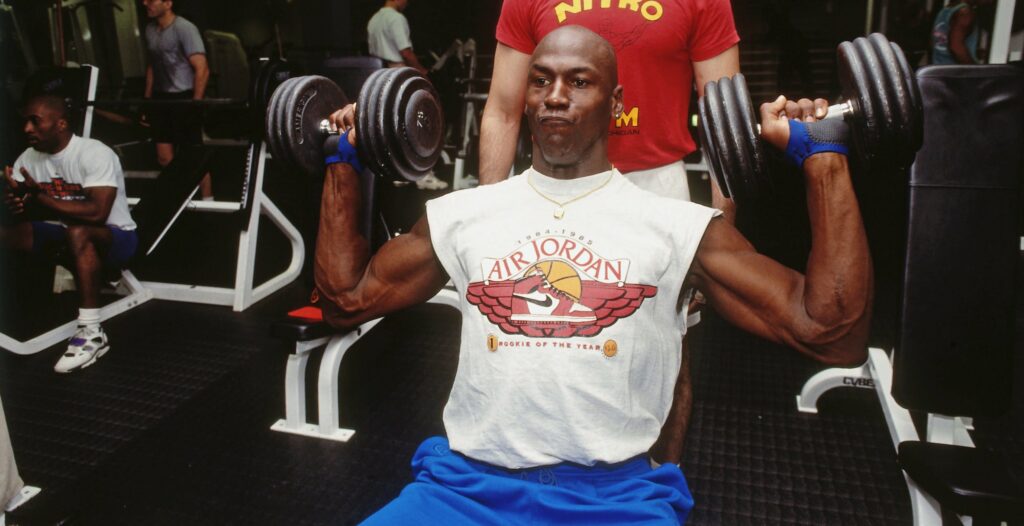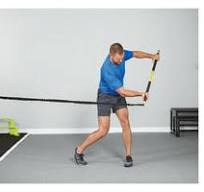
In the last decade and a half, there has been a big push for prioritizing “functional” training in the weight room. What defines functional training? Exercises that promote balance and coordination, involving multiple joints and muscle groups – all worthy components of any effective training program, to be sure. Many present-day supporters of functional training believe that the bulk of an athletes’ training time should be spent on exercises that closely mimic the demands of a sport or profession. But what does history tell us? And can spending too much time with these repetitive movements affect an athlete’s potential for overuse injury?
Let’s consider the case of Michael Jordan – an athlete who many consider to be the best of all time. MJ’s Chicago Bulls teams of the late 1990s TWICE accomplished a feat that has never been duplicated since the 60’s Celtics: three-peat championship runs and 6 NBA titles in the span of 8 seasons (including a record-setting 72-10 season in 1996). Jordan, Scottie Pippen, and Dennis Rodman formed the foundation of those teams’ most successful years; three players with 23 All-Star appearances and 17 championship rings between them. Moreover, these three played an average of 15 NBA seasons – when today’s average NBA career length is one-third of that span.
When watching “The Last Dance” (a popular documentary chronicling the successful dynasty of Jordan’s Bulls), hours of footage reveal MJ, Pippen, and Rodman adding foundational strength and bulk to their frames using lots of free weights, Nautilus and Cybex machines as an integral part of their workouts. Yet these are pieces of equipment that many coaches today see as “impractical” or “not functional”…in addition to being costly or taking up too much square footage in a facility. So what gives?
Legendary trainers like Chip Schaefer and Tim Grover realized that their Bulls players were getting so much of what they needed in terms of conditioning, footwork, agility, coordination, and balance during the course of a long and grueling 82-game season – just by playing the game each night. They had the wisdom and foresight to use weight room periods to maximize strength, power, and lean muscle mass to support the players’ skeletal frames – during an era that was even more physical and reckless on the body. Interestingly, research performed after Jordan’s runs revealed a 12.4% increase in NBA injuries over a 10-year period.

A “functional” movement example seen above
Granted, we have made good strides with human performance in the last decade-plus; with a better understanding of force-velocity curves, ideal loads for power training, and optimizing sports nutrition as just a few examples. But what do “functional” movements really do for you that traditional strength training cannot? Free weight dumbbells, loaded bars, and even many types of pulley or cable machines not only peak strength and power by activating multi-joint muscles at a higher magnitude, but they also can promote balance and coordination with many different variations in their own right.
So…if functional training can be defined as being strong across several different types of movement (or not too strong in one area versus another), then it is up to a good strength coach to have several different gym tools at their disposal – AND to realize the impact that movement inherent with a sport or occupational activity is having on the athlete outside the weight room already. What is to be gained by doing several AMRAP sets or 100 reps of the same movement? Does an athlete get as much benefit performing a movement balanced on an inflated ball or cushion as they would under a heavier load in more dynamic fashion with greater, more realistic ground reaction forces?
Again, it all comes down to how you define functional. For many athletes, it could be a 20-yard sprint burst. For a tactical operator, it could mean lifting the bulk of a 1,000 pound beam off of a trapped fellow firefighter. For a senior citizen, it may be maintaining enough single-leg strength to prevent a knee injury following a misstep on their favorite hiking trail. A truly valuable coach or trainer must be able to recognize the potential benefits of ALL types of training and portion out their workout accordingly – rather than restricting or limiting their programs to only follow the “functional” movement fad.
-CHRIS BORGARD
